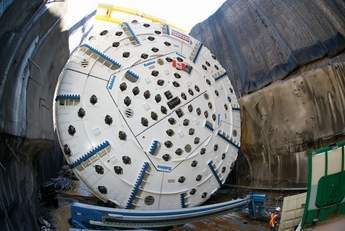Progress is pushing ahead on OPG’s Niagara power tunnel after earlier geological difficulties. By Patrick Reynolds

By last month, two-thirds of the Niagara power tunnel being bored by design-build contractor strabag for Ontario Power Generation (OPG) using a hard rock TBM had been excavated, and the machine is driving along a realigned route following earlier geological difficulties.
The 14.4m diameter main beam TBM, manufactured by Robbins, had bored 6.8km of the 10.4km long power tunnel by early June. OPG had reported in its first quarter results, to 31 March, that the TBM had advanced almost 6.5km – progress of 2.7km over the previous 12 months. With the alignment raised by 45m, the TBM is out of the Quenston shale that had proven troublesome and is mostly now meeting whirpool sandstone with tunnelling conditions further improving.
Strabag’s project manager, Ernst Gschnitzer, said: “We are happy with the current rock conditions and ground support system, as we haven’t been short of challenges in the past.”
Niagara Tunnel Project will be the third headrace below Niagara Falls and will help make use of the presently untapped allocation in Canada’s share of the water under the 1950 Treaty with the US. Concept work on the power tunnel project began in the early 1980s. The 12.8m i.d. tunnel now under construction will convey a further 500m3/s of water to the Sir Adam Back complex and add an extra 1.6TWh/year of electricity generation.
The TBM – “Big Becky” – is the largest hard rock machine manufactured and was also the first that Robbins assembled at a project site using its Onsite First Time Assembly (OFTA) system, which has now been used for a number of shields, such as for projects in Asia. The machine was launched in September 2006 to drive from the outlet at a grade on just less than 8 percent, and which took the tunnel through 10 layers of near horizontal strata, comprising limestone, dolomite, sandstone and then reaching shale.
Originally, the project was to have been completed by last month. However, extensive difficulties with overbreak in the Queenston shale led to delays and safety concerns. OPG has noted that crown overbreak in the shale was up to 4m in depth into the rock and averaged about 1.5m. Significant modifications were needed behind the cutterhead to the initial support area for the excavated rock and worker safety. Adjustment to the new system temporarily slowed the TBM progress when underway again.
The new, revised ground support system comprises spiles, rock bolts, mesh, steel straps and shotcrete. The grouted spiles are 9m long to help contain overbreak, and the rockbolts are 4m long, but in leaving the Queeston shale the need for the spiles lessened.
Last year the contract between OPG and Strabag was renegotiated and the tunnel realigned. The revised schedule is for the contract to be completed by the end of 2013 and the budget has been increased by about 60% to approximately Can$1.6bn (US$1.5bn).
Last year, though, in the third quarter a further rock fall happened more than 3km behind the TBM, in a stretch of tunnel that had previously suffered from problems of crown overbreak in the Queenston shale. No injuries were caused by the incident. While the relatively small rock fall was investigated and repaired, some select area of work were resumed and the contractor also took the opportunity to bring forward planned maintenance on the tunnelling equipment.
Behind the TBM, almost 5km of invert concreting of the secondary, permanent lining had been completed by May. In its Q1 results, OPG said just over 4.5km of permanent invert had been placed by 31 March.
Separately, work has been underway to re-complete the circular profile of the tunnel to prepare for concrete arch lining and membrane placement, which are also making progress. By the end of Q1, reported OPG, the arch lining had advanced 1km and by early May the works had advanced by a further 300m.
The secondary, final, lining for the tunnel will be formed of 600mm thick continuously-poured concrete on a waterproof membrane. Concreting works, to place the upper two-thirds of the permanent lining over the invert is due to commence going into Q3.
OPG said the current progress should have the project completed by the revised deadline and budget, possibly at less cost. The renegotiated contract has incentives on delivery against the revised target schedule and cost.
